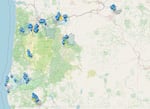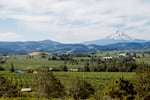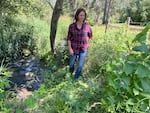
Oregon's Pesticide Stewardship Partnership program tests for pesticide pollution in watersheds across the state. The results are now available online.
Oregon Department of Environmental Quality / OPB
Fruit grower Brian Nakamura remembers when the state started pesticide testing in the streams near his orchards more than 22 years ago.
He can point to exactly what sparked him and fellow growers to launch a voluntary partnership that dramatically reduced pesticide pollution in the Hood River Basin.
“This is what triggered it,” he said, pulling out a photocopy of a 2001 newspaper clipping from The Oregonian.
“Pesticides pollute the Hood River for second straight year,” the headline reads.
To protect dwindling salmon and steelhead populations, Oregon environmental regulators had started testing the Hood River Basin for toxic pesticides that can harm fish. And they found concerning levels of azinphos-methyl and chlorpyrifos — two commonly used orchard sprays at the time.
The results made for a startling headline.

Fruit grower Brian Nakamura holds a 2001 newspaper clipping from The Oregonian that spurred him and fellow growers to launch a voluntary effort to reduce pesticide pollution in Hood River Valley streams.
Cassandra Profita / OPB
“That article kind of got everyone’s attention,” Nakamura said. “It was a surprise to everybody because the waterways had never been tested before at this level. My reaction at the time was we needed to do something.”
The growers’ response to the test results — and the implied threat of lawsuits or regulation that came along with them — gave birth to a whole new approach to reducing pesticide pollution in Oregon known as the Pesticide Stewardship Partnership program.
The program has been testing streams across the state for decades now and recently shared its results on a website that allows the public to see exactly which pesticides are polluting Oregon streams at testing locations in a dozen different watersheds.
Related: Pesticide Stwardship Partnership Data Viewer
Regulators say the results reveal strengths and weaknesses in the state’s voluntary pesticide pollution reduction program, as well as a snapshot of the prevalence of pesticide pollution in state waterways.
“It’s kind of everywhere — that’s what the data is showing,” Oregon Department of Agriculture pesticide stewardship specialist Kathryn Rifenburg said. “We don’t just sample agricultural areas. We sample in urban areas, we sample in commercial areas. We try to capture a wide variety of land uses.”
Rifenburg said she’s hoping the new data viewer website will lead more people and companies to reduce their pesticide use as the data itself has already done over the years.
Some argue the voluntary testing program has been more successful in reducing pesticide pollution than the regulations that would otherwise be needed to protect clean water and limit toxic chemical use.
Pesticide stewardship partnerships across the state have spurred farmers to switch to less toxic chemicals, change the way pesticides are applied and test alternative pest management options. Advocates say in many cases voluntary action has reduced pesticide pollution faster than rules and regulations.
But the program has limited funding and can only afford to test for pesticides in a fraction of the state’s watersheds. Critics say it could be more effective if the state returned to the system of pesticide-use reporting that it abandoned years ago, and they argue some of the most toxic pesticides still need better regulations or outright bans.
Lisa Arkin, executive director of the environmental group Beyond Toxics, said the options for controlling pesticide pollution are flawed and limited, and that’s why data from the voluntary stewardship program is so valuable.
“We have to start with good data,” she said. “Knowledge is power. The more the public knows, the better they will be in terms of assessing the harm or safety of pesticides in our waters.”
What the data viewer shows

The Pesticide Stewardship Partnership data viewer reveals about 90 different pesticides that have been detected in water samples over the last two decades.
Oregon Department of Environmental Quality
The Pesticide Stewardship Partnership data viewer reveals about 90 chemicals polluting streams in a dozen watersheds across the state over the last two decades — with levels ranging from very low to potentially harmful.
Some pollutants are more familiar than others — the bug spray ingredient DEET, for example, shows up at low levels and may be linked to bug-sprayed people swimming in the river.
One of the most commonly found pesticides is glyphosate, a widely used weed-killer in agriculture, forestry and road maintenance as well as in home and garden products like Roundup.
The second most prevalent pollutant is diuron, a toxic herbicide the Environmental Protection Agency recently proposed restricting because it carries cancer risks for people in addition to harming fish and wildlife.
In all, the pesticide stewardship program tests waterways for about 130 different chemicals. The data viewer site details how often those chemicals have been found, where they were detected and at what levels. Bar charts indicate which pesticides have been found at levels harmful to fish and other aquatic life.

The Pesticide Stewardship Partnership data viewer flags pollutants that have been detected above benchmark levels, which means they could be harmful to fish and wildlife.
Oregon Department of Environmental Quality
David Gruen, program manager for the Oregon Department of Environmental Quality, said the data could be helpful to people choosing where they want to go swimming or fishing.
“It’s important to remember that pesticides can have a negative impact on aquatic communities and human health at certain concentrations,” Gruen said.
The EPA sets benchmarks for pesticide levels that can be harmful to fish and wildlife, but many pesticides don’t have benchmarks. So, the danger posed by many pesticides in the database is unclear.
The site notes how much surrounding land is used for agriculture, forestry or urban development, which can offer some clues as to where certain chemicals are coming from.
But pesticides are notoriously difficult to trace because they can come from so many different places, and that can make it difficult to enforce standards set by the Clean Water Act. They can come from agricultural or residential weed and pest sprays, disinfectants that are designed to kill bacteria and even pet medications that kill fleas.
“It’s not coming from a single pipe,” Gruen said. “We use pesticides in many different sectors of the economy. Many people think of agriculture. But pesticides are also used in a number of other areas — in our home, in and around businesses, around roadways. Pesticide use is not just tied to agriculture.”
Gruen said DEQ and the Oregon Department of Agriculture create partnerships for voluntary pesticide pollution reduction in places where it’s likely pesticides are “not staying on target and are being transported into Oregon waters.”
The partners often include local agricultural groups, soil and water conservation districts and the Oregon State University Extension Service. They test the water and send the samples to DEQ for analysis, Gruen said, and the results often spur people into action — just like they did in Hood River.

The Pesticide Stewardship Partnership data viewer shows a noteworthy decline in the levels of the pesticide diuron in the Walla Walla Basin over the past decade.
Oregon Department of Environmental Quality
In Eastern Oregon’s Walla Walla watershed, for example, water sampling in 2010 and 2011 showed levels of the weed-killer diuron that were 19 times higher than the benchmark for harming fish and other aquatic life.
Gruen said the local irrigation district and watershed council worked with pea and wheat growers to control weeds with machines and switch to more targeted spraying of a less toxic herbicide. Since then, the diuron detections have declined significantly and haven’t exceeded the aquatic life benchmark in the last decade.
Getting ahead of restrictions
When the first pesticide partnership was created in Hood River, Nakamura said, fruit growers were hoping to avoid lawsuits and more pesticide regulations.
There had already been Endangered Species Act lawsuits filed to restrict or eliminate pesticide use in Washington because of their impacts on threatened and endangered salmon and steelhead. Hundreds of fruit growers in the Hood River Valley recognized that the DEQ results showing pesticide pollution in their watershed could mean more litigation.
More pesticide detections above aquatic health benchmarks would trigger Clean Water Act regulations, too, which would restrict the chemicals growers can use to control pests.
“In the food industry, it became apparent that there was going to be more restrictions on use of those chemicals because they affected salmon species all over the West Coast,” Nakamura said. “Obviously, the worst case would be to eliminate the use of it completely.”
As part of a fruit growers association with hundreds of members, Nakamura helped build a handbook about how to avoid spilling pesticides into streams and how to spray so chemicals don’t drift into public spaces or run off into waterways.
“Fortunately for the whole organization, everyone got on board,” he said. “Part of the impetus to get the whole program going so that we can show that, you know, we’re doing a better job.”

Fruit growers in the Hood River Valley organized the first pesticide stewardship partnership to reduce pollution after stream testing revealed harmful pesticides in the creeks surrounding their orchards.
Cassandra Profita / OPB
The Hood River Soil and Water Conservation District got involved in educating growers about pesticide use and started planting stream buffers to keep chemicals out of fish-bearing waterways.
Nakamura said they were “the guinea pigs” testing out a new, voluntary system of reducing pesticide pollution in Oregon.
And it worked.
Within a couple of years, the levels of the most toxic pesticides in Hood River Basin streams were steadily decreasing.
“Overall, they just kept going down,” he said. “It’s a success story. I was pretty proud that it was able to be expanded.”
The system worked so well that cherry growers in neighboring Wasco County asked the state to start another partnership for their watershed, and the state got funding to support the testing.
Faster than regulation
DEQ watershed manager Gene Foster was involved in the original studies that found harmful pesticides in the Hood River watershed.
“What that showed is that pesticides were getting in the water in some locations — not all,” Foster said. “That eventually changed how pesticides were being used because if the pesticide’s not staying in the orchard that’s not helping the grower either.”
The second year of testing showed a reduction in chlorpyrifos pollution the very next spring and a drop in azinphos-methyl levels that summer. Foster said that’s much faster than the Clean Water Act rules or pesticide restrictions could have worked to reduce pollution problems.

Lenz Creek is one of several tributaries to the Hood River that has been tested for pesticides regularly as part of the state's Pesticide Stewardship Partnership.
Cassandra Profita / OPB
“The growers were very progressive in trying to get out in front,” Foster said. “If there was a problem, they wanted to identify what the problem was and do something about it rather than waiting for regulation requirements to come in.”
Foster said fruit growers in neighboring Wasco County decided to install weather stations so they could apply pesticides when there’s less wind or rain to help keep the chemicals on target.
The program also led to innovations in pesticide spraying technology, he said, with sprayers releasing smaller droplets and allowing more focused, directional spraying.
Had the growers not addressed the problems proactively, DEQ would have had to design a program to reduce pollution under the Clean Water Act through a multi-year process called a total maximum daily load, or TMDL.
“It may not be as effective as a voluntary program,” Foster said.
The EPA and the ODA review the environmental and health risks associated with pesticides under the Federal Insecticide, Fungicide and Rodenticide Act, and they can impose restrictions.
But those regulations move slowly.
Eventually, the state of Oregon and the EPA restricted the pesticide chlorpyrifos because of its toxicity to people and wildlife, and by 2023 it will be almost entirely banned statewide.
But none of that happened until long after fruit growers in Hood River voluntarily started reducing chlorpyrifos pollution levels on their own in 2000. The pesticide stewardship partnership hasn’t detected any chlorpyrifos in the Hood River watershed since 2014.
“So we got 20 years of benefit before the regulations kicked in,” Foster said. “We were seeing improvements in water quality well before the regulatory apparatus was geared up and implemented.”
Voluntary action is limited
Arkin sits on the state advisory board for the pesticide stewardship program as an environmental advocate.
She said there are a lot of problems with the way Oregon controls pesticide pollution — including the long list of chemicals that don’t have specific toxicity standards.
“The benchmarks need updating,” she said. “A lot of these were set quite a long time ago, and they may not be protective of our water quality in the way we expect here in 2022.”
State funding for programs that reduce pesticide pollution is fragile and frequently at risk of being cut, she said, and some toxic pesticides still need to be banned altogether.
“One thing that I’ve learned is that certain pesticides show up almost everywhere, which should raise a red flag with our regulatory agencies that we should be doing more,” she said. “Diuron shows up all around our state, and it’s often over the benchmark for aquatic health.”
Arkin said she’s noticed a lot of detections of imidacloprid, an insecticide she says should be banned because it is so toxic to beneficial insects, birds and fish. The chemical accidentally killed about 50,000 bumblebees when sprayed on the linden trees in a Wilsonville Target parking lot in 2013.
The state’s voluntary pesticide program would be even more effective, she said, if people were reporting their pesticide use to help identify where pesticides might be coming from — a requirement that the state stopped enforcing after Oregon lawmakers dropped its funding.
But some groups involved in the pesticide stewardship program are sensitive to having their industries targeted, Arkin said and did not want to see the state’s pesticide testing database released to the public.
“I think that some industries are afraid of the public knowing too much,” she said. “Some didn’t feel it was a good idea for the public to have access to this data and were afraid of judgments that might be made on pesticide users.”
Some watersheds are complicated, others missing
Foster said it’s hard to use the state’s voluntary system to reduce pesticides in watersheds like the Clackamas River that have a wider variety of agriculture and pesticide uses than places like the Hood River Valley where most growers produce similar crops.
“It’s much more difficult for us to get a handle on those as far as what’s being used, when it’s being used and how to communicate with the stakeholders,” Foster said.
A federal study in 2008 found a long list of pesticides in the Clackamas watershed, which is surrounded by both industrial agriculture and residential development and provides drinking water to hundreds of thousands of people in the Portland metro area.
Many of the pesticides were found at levels that can harm fish and wildlife, and some were found in trace amounts in the area’s treated drinking water.
Since then, a voluntary partnership has been working to improve pesticide spraying methods and technologies, but the last two years of testing show four pesticides at levels exceeding aquatic health benchmarks, including chlorpyrifos and imidacloprid.
Other watersheds have no testing at all because analyzing water samples is expensive, and there isn’t enough funding to expand the program to all the areas that want them.
In Southern Oregon’s Illinois Valley, Cindy Palacios has been watching clear cuts wipe out huge stands of trees surrounding her home and wondering about the effects of timber companies spraying herbicides before the next tree plantings.
“It’s a huge part of it — the spraying,” she said. “They get sprayed and then, you know, it rains on them and they all feed the Illinois that supplies drinking water for the town of Cave Junction,” she said. “But I have yet to talk with anyone who had their creek tested.”
Palacios said she checked the Pesticide Stewardship Partnership data viewer and found there’s no pesticide testing happening near her community.
“It was just a big blank area for Southern Oregon,” she said. “We’re particularly interested to know what is getting in the creeks. We don’t have a baseline. We don’t know.”
More testing needed

Kris Schaedel with the Hood River Soil and Water Conservation District has been sampling the water in Hood River Valley creeks for the past ten years and sending the samples to the Oregon Department of Environmental Quality for testing.
Cassandra Profita / OPB
Kris Schaedel with the Hood River Soil and Water Conservation District pushes through tall grass and brush to reach one of the creeks her organization has sampled regularly over the last 10 years.
The narrow band of water in the creek cuts through a livestock pasture, oak woodland and a pear orchard that’s visible from Schaedel’s sampling site.
The state’s pesticide data viewer shows her samples contained potentially harmful levels of the pesticide imidacloprid last year. But the data also shows that was a rare event.
“We’re really not finding much,” Schaedel said. “Really, we’re finding very few products in very small quantities.”
The conservation district has helped the Confederated Tribes of Warm Springs and the Columbia Gorge Fruit Growers Association plant more vegetation around streams to create buffers that shield them from exposure to pesticides. It has also held workshops that teach growers to calibrate their pesticide sprayers to eliminate excess spray, which can reduce pollution and save growers money on pesticides.
Schaedel said the program’s voluntary approach helps ease the regulatory burdens that can drive farmers away from agriculture.
“One of our core missions is to keep farmers in farming … making it easier to farm, not harder,” she said. “The feedback we’ve gotten is that this program is important because it really is the data we can point to say, ‘Hey, the growers are really doing a pretty darn good job.’”
According to DEQ, the program has added more chemicals to the testing list over the years, including the Roundup ingredient glyphosate. But there may be more pesticides in use now that haven’t yet been added.
“Pest and disease pressure that didn’t exist 20 years ago is dominating spray programs now,” Schaedel said. “Certainly, we still have a lot left to do.”
